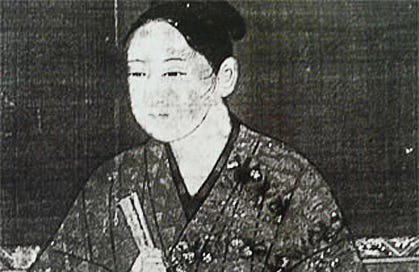Hashiba Hidekatsu died on January 29, 1586.
Born in 1568 as the fourth son of Oda Nobunaga, Hashiba Hidekatsu’s childhood name was Oda Otsugi or Otsugimaru. He was adopted by Nobunaga’s vassal Hashiba (Toyotomi) Hideyoshi. In November 1576, Hideyoshi, who had just lost his infant son, Hashiba Ishimatsumaru Hidekatsu, is thought to have appealed to his lord allowing him to adopt Otsugimaru as the successor to the Hashiba clan. It is believed that this was also to protect his own status, as Nobunaga favoured blood relatives. Another theory is that it was Hideyoshi's wife O-ne who begged Nobunaga to allow the adoption. O-ne was apparently unable to give birth to her own child and may have adopted the son of her lord to ensure the security of her household.
Exactly when Otsugimaru became Hideyoshi's adopted son is unclear, but it is the year after Hideyoshi’s son, the first Hidekatsu died. Among Hideyoshi's children (including adopted ones), three were named Hidekatsu, and so to distinguish this Hidekatsu from the other Hidekatsu, historians refer to him as Otsugimaru Hidekatsu (or Otsugi Hidekatsu) for clarity.
A joint signature of Hideyoshi and Otsugimaru Hidekatsu can be seen in the donation book of Nagahama Hachiman Shrine dated March 1583.
Hideyoshi had been awarded Nagahama Domain in northern Omi, (Shiga Prefecture) and was often absent from his lands on campaigns and official duties. During these times, Hideyoshi entrusted the control of Nagahama to Hidekatsu, who was 13 years old at the time, and is known to have signed domain documents in his adopted father’s place.
On March 8, 1582, Hideyoshi led his troops to conquer the Chugoku region under the orders of Nobunaga and attacked Bitchu (Okayama Prefecture). This was to be Hidekatsu’s first battle on the 17th at the attack on Tsuneyama Castle in Kojima, Bizen. He saw further action in the siege of Takamatsu Castle in April. On June 2, after his biological father, Oda Nobunaga, was killed in the Honno-ji Incident. Hidekatsu accompanied Hideyoshi on his Great Return, the term for Hideyoshi’s remarkable feat of logistics, ending and extracting 30,000 troops from a siege situation, propelling them on a forced march of over 200km to an area south of Kyoto, to reform as an attack force to face the Akechi in the Battle of Yamazaki less than 10 days later on June 13. As Nobunaga's fourth son, along with his half-brother, Oda Kobe Nobutaka, Hidekatsu became a flag bearer in the revenge battle.
Nobunaga’s designated heir, Nobutada had been killed fighting the Akechi that same day, and so the Kiyosu Conference was held to decide the Oda clan future on June 27 at the Oda clan’s Kiyosu Castle. It was speculated that Hideyoshi would recommend Hidekatsu as the successor to the Oda clan, but instead Hideyoshi recommended Nobunaga's eldest grandson, the 3-year-old Sanboshi, son of Nobutada, and in turn gained the support of almost the entire clan. As a result, Hideyoshi became estranged from Shibata Katsuie, who had nominated Nobunaga’s third son, Nobutaka. Due to a redistribution of the Oda clan's territories, Hideyoshi was given the strategically important Tanba Province, which was the former territory of Akechi Mitsuhide, close to Kyoto. Hidekatsu was to become the lord of Tanba Kameyama Castle, but in return, the 60,000 koku Omi domain, including Nagahama Castle, was to be given to Katsuie's adopted son, Shibata Katsutoyo. Katsuie had to pass by Nagahama Castle on his way back to his territory in Echizen (Fukui), but he expected that the Hashiba would refuse to surrender the castle, so he stopped in Tarui, Mino, fearing an attack. Hideyoshi was furious and offered Hidekatsu as a hostage to guarantee that he would not be attacked. After Katsuie passed through safely, he immediately sent Hidekatsu back, and Hideyoshi took him to Kyoto to hold a memorial service for Nobunaga at the remains of the Honno-ji Temple.
By October, Nobunaga's official funeral had still not been held, and so Hideyoshi, who aimed to become the next ruler of Japan, staged a large memorial service at Kyoto’s famed Daitoku-ji Temple which lasted a week. The front part of the coffin was carried by Ikeda Koshin, the son of Nobunaga's foster brother Ikeda Tsuneoki, and the rear part by carried by Hidekatsu. Hideyoshi himself carried the memorial tablet and sword and acted as the chief mourner. The guardians of Sanboshi, Nobunaga’s second and third sons, Oda Nobukatsu and Nobutaka, and the senior retainers Shibata Katsuie and Takigawa Kazumasu did not attend. Hidekatsu left the funeral on the 15th and entered Tanba Kameyama Castle. Later that year, Hidekatsu became engaged to Mori Terumoto's adopted daughter, the biological daughter of Naito Mototane.
In 1583, he participated in the Battle of Shizugatake against Shibata Katsuie’s forces, and the following year, participated in the Battle of Komaki and Nagakute, setting up camp at Kusatsu in Omi, where he played an active role in the attack on the Kiso River. His health is said to have begun to deteriorate around this time, and he was kept at Ogaki Castle from midway through the battle. Despite this, in late January of 1585, Hidekatsu and Terumoto's adopted daughter’s wedding ceremony was held in Osaka Castle. Almost a year later, he fell ill again and died on January 29, 1586 at Tanba Kameyama Castle. He was 18 years old. According to Yamashina Tokitsugu's diary, Hidekatsu's birth mother, Nobunaga’s concubine, Yokan'in, was still alive at the time and was by his side. There are rumors that Hidekatsu was killed on the orders of Hideyoshi, although this cannot be proved, and as There is a theory that Yokan'in was also the mother of So'o'in, Nobunaga's second daughter, in which case the warrior Gamo Ujisato would be the brother-in-law of Hidekatsu.
There are four graves for Hidekatsu , at Kyoto’s Sogen-in Temple in the Daitoku-ji Temple, which Hideyoshi built as the Oda clan temple. At Zuirin-in Temple at Chion-ji Temple, also on holy Mount Koya, and at the Amida-ji Temple. A wooden likeness of Hidekatsu is at kept Zuirin-in Temple within the Chion-ji Temple complex. A portrait of Hidekatsu based on the statue is at Chion-ji Temple.
The Sengoku period is a confusing time to study, with samurai names changing on a regular basis, children being used as hostages and pawns in the political games of the time, and adoptions between clans and vassals taking place regularly. Hideyoshi’s penchant for the name Hidekatsu, and all dying at a young age has simply added to this confusion.






